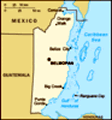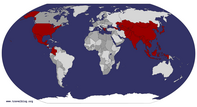Advertisement
Published: July 14th 2018
Our passage into Belize got off to an inauspicious start when we arrived at the Chetumal ferry terminal to learn that our crossing had been cancelled due to an unserviceable boat. However, the company had decided to honour our booking by agreeing to fly us over to Ambergris Caye from the town of Corozal in Belize. With no obvious procedure in place, the lady behind the counter drove us over the border in her own car and we had just enough time to pay the immigration agent a questionable exit fee to depart Mexico before reaching the airstrip in time for our flight.
Our unforeseen good luck was in danger of disappearing almost as soon as it had materialised when we were told the flight was overbooked and the check-in agent asked if one person would mind catching the next flight. We were all savvy to that particular deception though and nobody in our group volunteered for an almost certain overnight layover in town. This (Mexican) stand-off paved the way for an entertaining screaming match at the counter involving one local who refused to be bumped off the flight because of ‘all the white people’ - we really need to
work on our tans. We eventually boarded with the protagonist bizarrely buckling herself into the co-pilot’s seat in time for take-off having obviously proven the adage that ‘the obnoxious customer is always right’. The flight time to San Pedro was a gruelling 15 minutes and we were treated to spectacular views of Corozal Bay as we approached the famous ‘La Isla Bonita’ that Madonna was going on about.
Despite, the short distance between the two countries, Mexico and Belize seemed worlds apart on first impressions: we said goodbye to Tacos, Cervezas and Mariachi and said hello to Jerk Chicken, Rum and Reggae. Ambergris Caye has a distinctly Caribbean feel to it, heavily influenced by the local Creole population and at 25 miles long, it is the biggest and most developed island in Belize.
English is the national language here, although Spanish, Creole, Garifuna and Mayan are also widely spoken in Belize too. Being a former British colony and remaining member of the commonwealth, the image of Elizabeth II appears on the banknotes - even British food seems to be popular, with meat pies and fish and chips on the menu at a number of the local restaurants.
After enjoying the benefits of the Australian dollar to the Mexican peso exchange rate for so long, it was an eye-opener to be confronted by the strength of the Belizean dollar in comparison – the cost of some things here are on-par with Melbourne. The local supermarket doesn’t even display the price of their goods, presumably because they want to delay the shock until you reach the check-out.
San Pedro is surprisingly built up for an island, and it was strange to see traffic police on duty to deal with traffic jams at the peak hours of the day. We hired a golf cart to ferry us around the course of the island, and we managed to routinely get hijacked by local kids hitching a ride to school on the back of the cart. No offer to chip in for petrol though which we thought was a bit tight of them.
After three days on Ambergris Caye, we took a water taxi across to the smaller Caye Caulker and the difference between the two was noticeable straight away. The place is so relaxed that the only sign on display read ‘Go Slow’, an instruction that serves as the
ethos of the island as a whole. It has a small Rastafarian population who contribute to the easy-going attitude that permeates the Caye, although the novelty of the incessant Bob Marley soundtrack had worn itself out by day two. The 1961 Hurricane Hattie created what is known as the split, where the island has been fractured into two halves. The promenade at the northern tip of smaller portion acts as the unofficial centre of the island, the focal point of which is the Lazy Lizard bar - a hive of activity due to its snorkelling and sailing facilities and picture-perfect layout for sunset.
Our primary intention here was to snorkel on the world’s second biggest coral reef – apparently there’s a larger one near Australia somewhere – and is 185-miles long and home to more than 400 species of fish. On the day, we were fortunate to swim alongside manatees, sharks, rays, turtles and thousands of fish before finishing at an off-shore shipwreck.
After three days on the Cayes, we had decided that it was time to leave the water behind for the time being and head inland for some jungle adventures in the town of San Ignacio.
We took a water taxi over to Belize City and from there headed west through the capital Belmopan to our destination on the western frontier.
After the scale of some of the journeys we had undertaken in Mexico, it was a nice bonus that we could cover the entire width of Belize in 2 hours; the country measures just 170 miles from north to south and 68 from east to west. With a population of a little over 380,00 it is one of the least populated mainland countries on earth, yet attracts a million visitors annually. The fact that the nation is made up of over 450 islands, or Cayes, with only 49% of the country on the mainland is a big reason why tourism is such an important part of the economy.
Shortly after arriving in San Ignacio, we visited the ruins of Cahal Pech and Xunantunich; we reached the latter by a local bus which is a fleet of old, yellow American school buses that never fail to remind me of a Nightmare on Elm St Part 2, and were definitely not designed with comfort in mind. At the end of the journey, we proceeded to
a hand-cranked cable ferry that transports passengers across the Mopan river. At the ruins, we scrambled our way up 135 feet of stone steps to the summit of El Castillo where we had a view of the valley into Guatemala, which lay just 150 metres from the central plaza.
One of the main attractions in this part of the country is the Actun Tunichil Muknal cave – more commonly known as the ATM – and people come from all around to experience this unique opportunity to venture into the Mayan underworld. It is the number one attraction in Belize and has been voted in the top ten caves in the world by National Geographic – both the History and Discovery Channels have made documentaries about the place - as has Bear Grylls.
Our guide picked us up from our hostel early, and it soon dawned on us that we had been pinged with Danny – a man that one reviewer on Trip Advisor had been moved to describe as ‘vile’. Mr Vile had arranged to collect our lunches on the way to the caves, but he explained that he wasn’t eating himself, as he was sick. This was
at odds with his behaviour on the drive out of town as he demolished the three pies and a bottle of coke that supposedly doesn’t qualify as food to him. The rest of the journey was taken up listening to him air his absurd worldviews, and we were left to contemplate who he hated the most: Americans or his ex-wife.
The cave is located in the Tapir Mountain Nature reserve, an hour and a half outside San Ignacio and we drove through mahogany, teak, almond, palm, plantain and orange tree plantations as we made our way down the makeshift road to the ranger station. From here we commenced our 45-minute hike through the jungle, which included three river crossings in which we waded through water at shoulder height. We were then issued with our helmets and head torches before swimming across a spring-fed pool as this was the only way to access the cave entrance.
For the next three hours, we walked, swam, scrambled, crawled and climbed our way around the extensive underground maze of tunnels, passageways and chambers that make up the cave network. In the first section, we navigated through water up to our necks as
we squeezed through gaps in the rock barely bigger than our heads – an element of the exploration known as ‘decapitation rock’ which may have been the last straw for anyone of a claustrophobic nature.
After we completed the first half of the cave, we climbed up into the ceremonial chamber of the cave, via a rickety ladder followed by a quick scale up the cave wall. It was in this room that Mayans once carried out human sacrifices and the remains of a 1400-year-old crystallised skeleton lie here, concealed in a small recess. From this chamber, we made our way back the way we came, and as our charismatic leader seemed to be in a rush to get home, we made it back to the entrance in good time. It was an exhilarating trip and alongside Caye Caulker, was probably the highlight of our time in Belize.
Our last day in the country was spent watching some of the World Cup and plotting the next part of our trip - across the border into Guatemala. It would have been good to spend more time in Belize, but the costs of travel prevented it, we could see why
most backpackers we met passed through quite quickly. We were also eager to see what Guatemala has in store for us as the reviews we have heard so far from other travellers have been unanimously positive.
Advertisement
Tot: 0.19s; Tpl: 0.014s; cc: 9; qc: 56; dbt: 0.0452s; 1; m:domysql w:travelblog (10.17.0.13); sld: 1;
; mem: 1.2mb





















